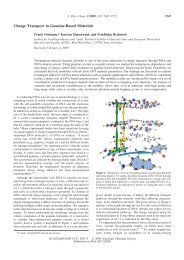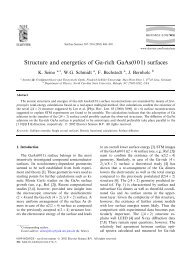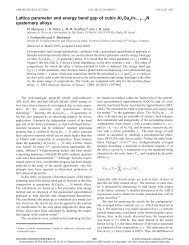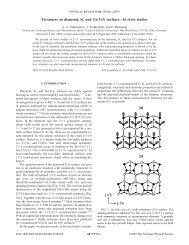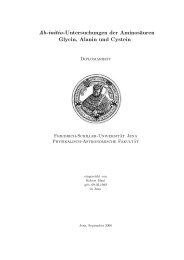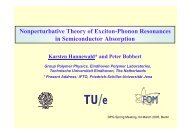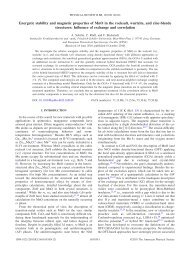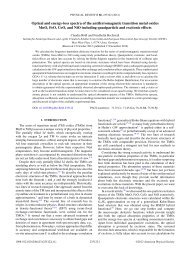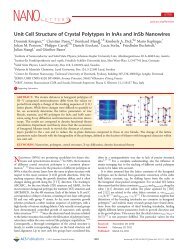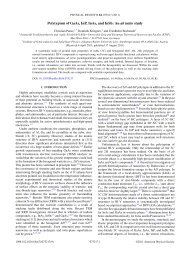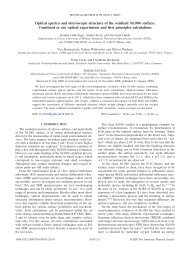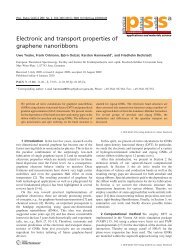Beyond the GW approximation - APS Link Manager - American ...
Beyond the GW approximation - APS Link Manager - American ...
Beyond the GW approximation - APS Link Manager - American ...
Create successful ePaper yourself
Turn your PDF publications into a flip-book with our unique Google optimized e-Paper software.
BEYOND THE <strong>GW</strong> APPROXIMATION: COMBINING ... PHYSICAL REVIEW B 85, 155131 (2012)<br />
FIG. 2. (Color online) Schematic representation of <strong>the</strong> physical contents of <strong>GW</strong> (a), pp T matrix (b), and eh T matrix for particles with<br />
collinear spins.<br />
becomes<br />
(11 ′ ) ≈ v H + x + iv c (12)ɛ −1 (72)G(13)<br />
[ δ(31 ′ ]<br />
)<br />
×<br />
δG(45) G(47)G(75) . (26)<br />
Note that this is <strong>the</strong> same equation as Eq. (4), but now with<br />
W = ɛ −1 v c replacing <strong>the</strong> bare Coulomb interaction under<br />
<strong>the</strong> integral. This leads to a screened matrix O: (11 ′ ) =<br />
G(42)Os<br />
pp (12; 1 ′ 4), with Os<br />
pp = O pp<br />
s,1 + Opp s,2 and<br />
O pp<br />
s,1 (12; 1′ 4) =−iv c (12)δ(11 ′ )δ(42)<br />
+ iW(12)G(13)G(25)O pp<br />
s,1 (35; 1′ 4), (27)<br />
O pp<br />
s,2 (12; 1′ 4) = iv c (12)δ(14)δ(1 ′ 2)<br />
+ iW(12)G(13)G(25)O pp<br />
s,2 (35; 1′ 4). (28)<br />
In principle, one could include also a nonlocal part of <strong>the</strong><br />
exchange-correlation self-energy, but <strong>the</strong> equations become<br />
more involved.<br />
As for <strong>the</strong> T matrix, also for <strong>the</strong> screened version one has<br />
O pp<br />
s,2 (12; 1′ 4) =−O pp<br />
s,1 (12; 41′ ). Similarly, one can derive <strong>the</strong><br />
electron-hole screened T matrix, which looks like Eqs. (9) and<br />
(10) with W replacing <strong>the</strong> bare Coulomb potential in <strong>the</strong> last<br />
term on <strong>the</strong> right-hand side. When ɛ −1 = 1, and, hence, W =<br />
v c , this version of <strong>the</strong> screened T matrix reduces to <strong>the</strong> one<br />
of Refs. 17 and 56. Note that <strong>the</strong> Hartree and exchange parts<br />
remain unscreened, which is in net contrast with o<strong>the</strong>r versions<br />
of <strong>the</strong> screened T matrix reported in <strong>the</strong> literature. 12,34–39<br />
It is interesting to take <strong>the</strong> screened T -matrix equation in<br />
its first iteration: In this case, <strong>the</strong> self-energy (particle-particle<br />
version) becomes<br />
pp,(1)<br />
s,1<br />
(11 ′ ) = δ(11 ′ )v H (1) + iW(12)G(11 ′ )v c (1 ′ 4)L 0 (24),<br />
(29)<br />
pp,(1)<br />
s,2<br />
(11 ′ ) = x (11 ′ ) − W(12)G(14)v c (41 ′ )G(21 ′ )G(42),<br />
(30)<br />
with L 0 (24) =−iG(24)G(42). The electron-hole screened T<br />
matrix produces <strong>the</strong> same self-energy as <strong>the</strong> particle-particle<br />
screened T matrix in its first iteration, as in <strong>the</strong> case of <strong>the</strong><br />
T -matrix <strong>approximation</strong>. Moreover, <strong>the</strong> resulting self-energy<br />
is exact to second order in <strong>the</strong> Coulomb interaction.<br />
In <strong>the</strong> RPA, W(12)v c (1 ′ 4)L 0 (24) = [v c + v c L 0 v c /(1 −<br />
L 0 )v c ]L 0 v c = W − v c .Thesumof 1 and 2 yields, hence,<br />
<strong>GW</strong>, plus <strong>the</strong> last term of 2 . In Fig. 3 we report <strong>the</strong><br />
diagrammatic representation of this self-energy: The first<br />
two diagrams represent <strong>the</strong> Hartree and <strong>GW</strong> contributions,<br />
respectively, whereas <strong>the</strong> last one is a term corresponding<br />
to <strong>the</strong> second-order screened exchange (SOSEX). The latter<br />
contribution is becoming popular as correction to RPA in order<br />
to produce accurate results in <strong>the</strong> description of electronic<br />
correlation in atoms and solids. 57<br />
We, hence, can conclude that <strong>GW</strong> is contained in this<br />
screened T -matrix approach, which, moreover, contains<br />
promising higher-order terms. In literature o<strong>the</strong>r versions of<br />
<strong>the</strong> screened T matrix 12,34–39 are proposed which are combined<br />
with <strong>the</strong> <strong>GW</strong> <strong>approximation</strong> to get <strong>the</strong> total self-energy.<br />
However, since some of <strong>the</strong> terms in <strong>the</strong> T matrix are already<br />
contained in <strong>the</strong> <strong>GW</strong> <strong>approximation</strong>, care must be taken<br />
to avoid double counting. In our formulation, instead, <strong>the</strong><br />
screened T matrix naturally contains <strong>GW</strong>; <strong>the</strong>re is, hence,<br />
no need to add ad hoc corrections.<br />
Because of <strong>the</strong> appearance of both v c and W, <strong>the</strong> screened<br />
T -matrix <strong>approximation</strong> of Eqs. (27) and (28) does not fulfill<br />
some symmetry conditions to be fully conserving, unlike selfconsistent<br />
<strong>GW</strong> and (unscreened) T matrix. 17 For example, <strong>the</strong><br />
momentum conservation law is violated.<br />
FIG. 3. Diagrams corresponding to <strong>the</strong> self-energy obtained with <strong>the</strong> first iteration of <strong>the</strong> screened T matrix I. The diagrams, from left to<br />
right, represent <strong>the</strong> Hartree, <strong>GW</strong> , and second-order screened exchange (SOSEX) terms, respectively. Note that in <strong>the</strong> <strong>GW</strong> term we collapsed<br />
<strong>the</strong> two terms that for ɛ −1 = 1, i.e., W = v c , reduce to <strong>the</strong> second and first diagrams of pp/eh<br />
1 and pp/eh<br />
2 , respectively, of Fig. 1.<br />
155131-5



